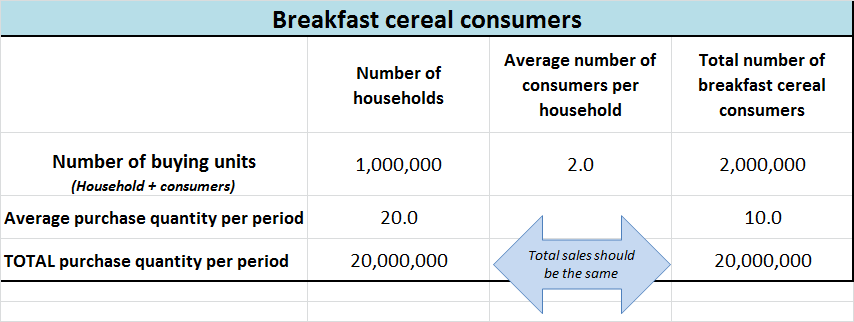Get the free ATAR forecasting model: Free Download: ATAR Model Excel Template
What is a “buying unit” in the ATAR forecasting model?
The starting point in the ATAR forecast is the number of buying units, which is sometimes a misunderstood term.
Unfortunately, some marketing students confuse the term “buying units” with “sales units” (or number of units purchased). However, these two terms are completely unrelated and could lead to concerns and miscalculations in the ATAR forecasting model.
In the ATAR model, buying units refer to the number of consumers (or sets of consumers) in the marketplace.
So a good question is why is the term “buying units” is used instead of “numbers of consumers”? There is a reason why this is in place – because the ATAR forecast model can be appropriately used for more than just individual consumers.
Here is a list of possible alternative “buying units” may be used in the ATAR model:
- households
- family units
- individual consumers
- organizations – profit or NFP
- businesses (or industries)
- government departments
- government facilities (schools, hospitals, transport, colleges)
An example of buying units versus individual (or sets of) consumers
Let’s take the example of breakfast cereal to help clarify the difference between the buying unit and an individual consumer.
Let’s assume that in a particular city there are 1 million consumers of breakfast cereal and these these consumers reside in 500,000 household units. Some of these consumers are in single-person households, whereas others reside in a couple or family situation – with the average number of consumers being 2.0 per household.
Most commonly, breakfast cereal is the type of product that is typically purchased by the main grocery buyer on behalf of either the family or household.
Therefore, for this particular product category, in the ATAR forecast model, we should determine that our buying units are households (with the main grocery buyer) – with the input into the ATAR model being 500,000 households.
To complete this example, let’s also assume that each household purchases 20 packets of breakfast cereal each year – which is an average of 10 packets per individual consumer in the household.
IMPORTANT: Align buying units with average purchase quantity
When you use buying units at a household level – which is correct for this example – you also need to ensure that the average quality purchased (sales units per buying units) is also aligned. This is where confusion can often occur only to miscalculations in the ATAR forecasting model.
Review the below table as an example, where we have included our assumptions for this example. As you can see, provided that you use the appropriate information at either the household or the individual consumer level, the correct number should be generated.
TAKE CARE: However, if you were to use average purchase quantity per household (which is 20 packets), but also use individual consumers (which is 1 million) – then you would have a substantial overstatement (doubling in this example) of the likely sales of the product in the ATAR forecast.
What is the ATAR forecast model?
The ATAR forecast model is a marketing model that stands for Awareness, Trial, Availability, and Repeat. It is a framework used to forecast and analyze the potential success of a new product or service in the market.
Here’s a breakdown of each component:
1. Awareness: This refers to the level of consumer knowledge or recognition of a particular product or brand. It measures the extent to which the target market is aware of the product’s existence and its features.
2. Trial: Trial represents the initial purchase or usage of the product by consumers. It focuses on encouraging potential customers to try the product for the first time, often through promotional activities, free samples, or trial offers.
3. Availability: Availability refers to the accessibility and distribution of the product. It considers factors such as the product’s physical availability in stores or online, the ease of purchasing or obtaining it, and the overall convenience for customers.
4. Repeat: Repeat refers to the likelihood of customers repurchasing the product or becoming loyal to the brand. It measures the rate at which customers continue to buy the product after the initial trial, indicating their satisfaction and loyalty.
Find Out More About ATAR Forecasts
- Most ATAR factors are interrelated
- Benefits of the ATAR forecast model
- Limitations of ATAR forecasting
- Availability in ATAR Forecasts
- Trial in the ATAR Forecast
- Awareness in the ATAR Model
- Rebuy/repeat in the ATAR forecast model
- ATAR Examples for Two Small Businesses
- How the ATAR Forecasting Model Works
- ATAR Model: Guide to Prices, Costs, Margins, Quantity
- ATAR Theory
- ATAR Formula
- Buying Units in the ATAR Forecast Model

